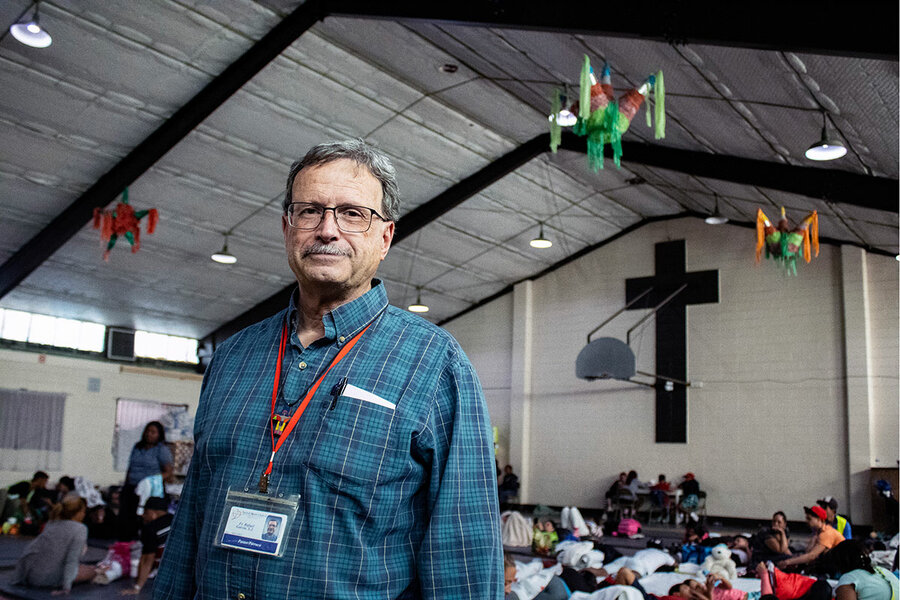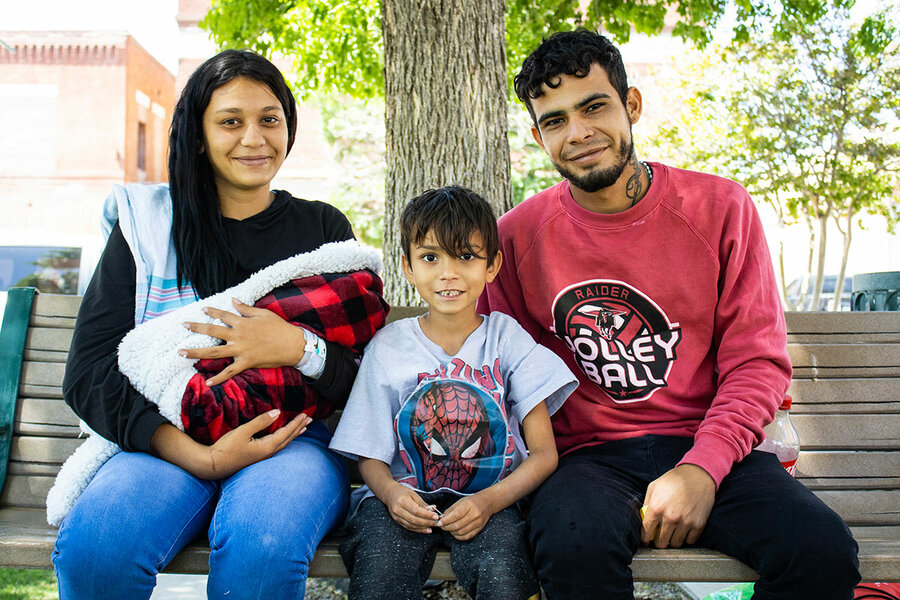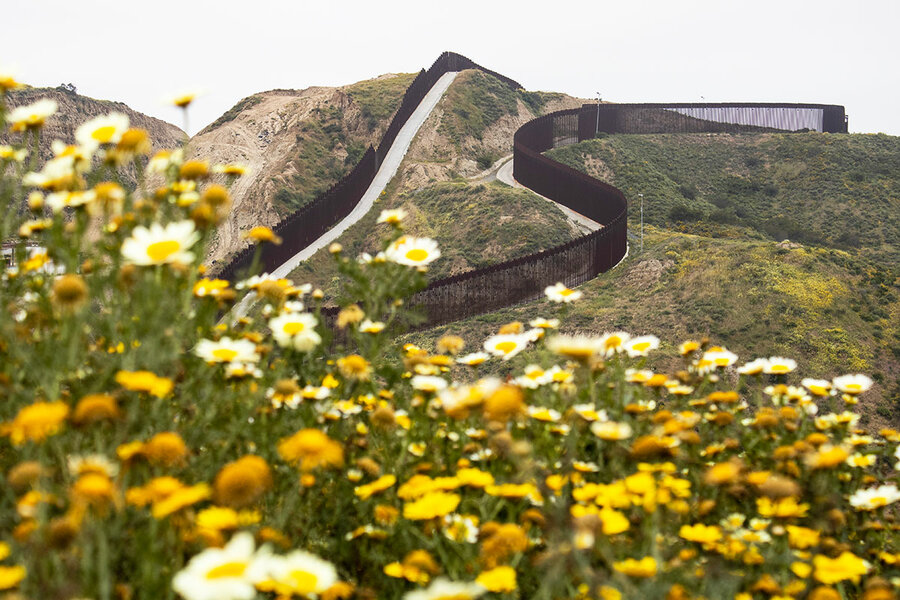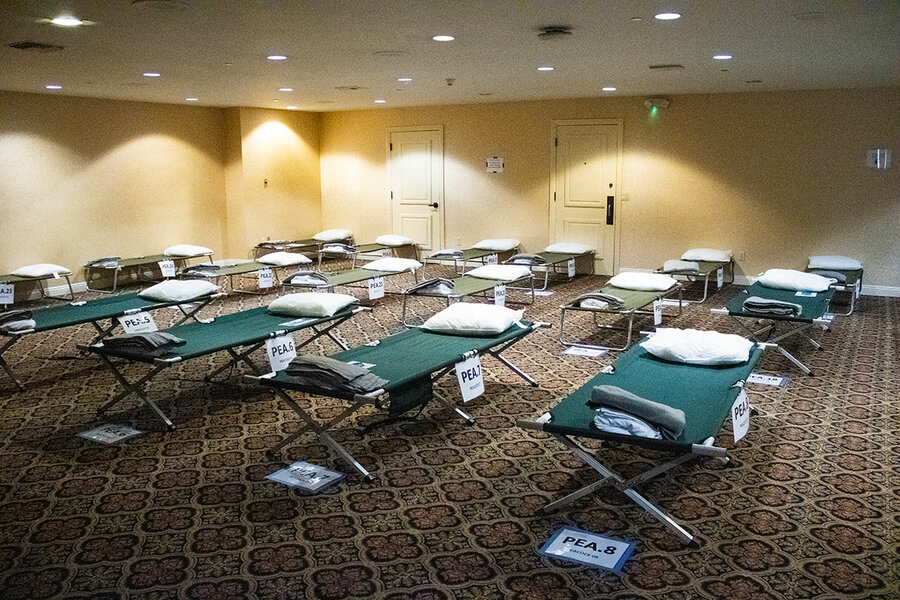
The United States is about to begin a new chapter in its fraught immigration policy. At midnight on Thursday, a provision that built a procedural wall against migrants – if not a physical one – is set to expire. American communities along the Mexican border are preparing for an influx of humanity, which has already begun in some areas.
The provision, known as Title 42, is part of the public health code that the Trump administration invoked to restrict immigration three years ago. Arguing for the need to protect the nation against COVID-19, the government used the code to turn away asylum-seekers and other migrants at the border without the chance to seek protection. Though challenged in court, the controversial policy continued under the Biden administration, resulting in more than 2.8 million expulsions since March 2020 – including those who tried to cross more than once.
But with the COVID-19 public health emergency sunsetting in the U.S. this week, so too does the immigration provision, coinciding with the time of year when attempted border crossings traditionally increase. To prepare for an expected increase, the Biden administration on Wednesday finalized a rule that further restricts access to asylum. Deployment of troops and other personnel to the southwest border, along with funding boosts to border communities, is also part of plans. Meanwhile, House Republicans are expected to vote on their own border bill today.
Why We Wrote This
A provision that allowed the U.S. to expel asylum-seekers during the pandemic sunsets today. Even as the Biden administration and House Republicans clash over immigration policy, border communities prepare for an influx of migrants.
Anticipating change, Monitor reporters recently traveled to the border. This week, Latin America special correspondent Whitney Eulich chronicled the legacy of Title 42 on Mexican border cities that have swelled with migrants – and the difficulty that many of them have using the administration’s phone app to pursue asylum. Similarly, this reporter visited nonprofit migrant shelters on the receiving end in El Paso, Texas; and San Diego as they try to gear up for this next chapter.
“You need a plan to not create crisis in the local border communities,” says the Father Rafael Garcia of the Society of Jesus, the Jesuit pastor of Sacred Heart Church in El Paso. The church runs a shelter for migrants that is full up – even before the change.
Mr. Garcia is speaking specifically of the need for a plan to uphold the right to seek asylum in the U.S. Yet his words underscore a debate about how the U.S. should calibrate its responsibility to migrants and Americans, amid competing visions of a humanitarian versus security emergency at the border.
Overflowing in El Paso
Whatever change is coming, El Paso has been scaling up resources in the face of overwhelming need. In recent days, some 3,300 migrants have been staying on the streets around two shelters in the bustling downtown, many sleeping on scraps of cardboard.
Along with two other Texas cities, El Paso announced a state of emergency beginning May 1. That came five months after a similar declaration in December, when monthly border encounters reached a record.
That same month Sacred Heart, located just a few blocks from the Mexican border, opened its migrant shelter, a former parish gymnasium that holds up to 120 people.
In late April, many without shelter linger outside in the sun, unsure of next steps. They include asylum-seekers in fear of returning home as well as those in search of better economic conditions – which are not grounds for asylum. Many crossed into the U.S. unlawfully, encountering robberies and violence on their journey north. Some are hurt from scaling the border wall.
“I was robbed in the jungle; I was robbed on the train – I went through a lot,” says Katty, an Ecuadorian standing on the shadeless street outside Sacred Heart, who spent 12 days on the street without shelter. Like other asylum-seekers, she preferred not to have her full name published for privacy reasons.
Beneath a mural of the crucifixion, a group of men crowds around a gate where shelter workers call out the names of those who can come in. Inside, a boy pushes a lemon-yellow toy truck past rows of sleeping mats across the wooden floor. Germán, whose own son is still in Venezuela, has volunteered to sweep this floor since arriving earlier in the month.
“I’m super grateful,” says the asylum-seeker, who protested his government back home. “It’s great that places like this exist.”
Crowds around the shelter have reportedly thinned since then, following a federal informational campaign encouraging unauthorized migrants to turn themselves in for processing. Still, Mr. Garcia and his team are endeavoring to keep the shelter running, relying on private donations and volunteers. On a recent evening, a group of Latter-day Saint volunteers dons gloves to serve dinner to those who have secured a spot inside.
With no resources from the state, the church is applying for federal funds. The Federal Emergency Management Agency, or FEMA, has allocated funding for border cities to help with the reception of noncitizens released from custody.
The city, meanwhile, is readying vacant school buildings as temporary migrant shelters, and possibly resuming chartered transportation to move migrants on to their desired destinations. There’s a need to “decompress our system,” Mayor Oscar Leeser told reporters last week.
“As a border city, we have a responsibility to provide a service for our country and make sure that everybody is treated with dignity and respect,” said Mr. Leeser, a Democrat.
Though they’re accustomed to migration in a city with multiple ports of entry that shares its border with Ciudad Juárez, some locals find their patience tested by the volume of border crossers. “There is a lot of sympathy for their situation, but it is hurting us,” says Bobby Abner, from behind the counter of Paso del Norte Gold and Silver. The increase of migrants downtown has reduced foot traffic to his business.
Republican Gov. Greg Abbott, meanwhile, has pursued a plan of deterrence. The state reports directing $4 billion to border security, deploying National Guard members and state troopers, and laying miles of concertina wire along the border at El Paso. State law enforcement has apprehended more than 373,000 unauthorized immigrants since 2021. Critics have questioned the legality of expanding the state’s authority in immigration enforcements.
By letting Title 42 end, “President Biden is laying down a welcome mat to people across the entire world,” Governor Abbott said Monday, announcing a new Texas Tactical Border Force of National Guard members. “Texas is doing more than any state in the history of the United States of America to defend our border.”
Secretary Mayorkas: potentially “very difficult”
After Title 42 ends, border officials will revert to using traditional immigration law, which they’ve still applied to some extent throughout the pandemic. Removals of noncitizens under the law carry steeper penalties than Title 42 expulsions, such as a five-year bar on reentry and potential criminal prosecution for future attempts.
Department of Homeland Security officials are bracing for a continued influx of border encounters, and estimate that border agents may face as many as 13,000 migrants a day starting on Friday. Some reports suggest the influx is driven in part by border policy misinformation received by migrants.
“We are cleareyed about the challenges we are likely to face in the days and weeks ahead, which have the potential to be very difficult,” Secretary Alejandro Mayorkas said at a Wednesday press conference. “We are making it very clear that our border is not open.”
Many House Republicans disagree, calling for Mr. Mayorkas’ impeachment over what they call a colossal loss of control. They are expected to pass a border security bill Thursday that would build more border wall and place new restrictions on asylum-seekers. The bill has no future in the Senate, and the president has threatened a veto.
As Title 42 expires, the Biden administration’s plans include increased personnel and other resources for border operations and the interviewing of asylum-seekers, harsher targeting of smugglers, and regional processing centers in Central and South America to screen migrants for possible admittance.
The new rule announced Wednesday restricts asylum-seeking to “lawful pathways,” i.e., ports of entry and the use of the CBP One phone app, and only after an attempt to seek relief in another country is denied. Immigrant advocates have decried such limitations, which they see as reminiscent of the Trump era.
Aaron Reichlin-Melnick, policy director at the American Immigration Council, argues the Biden government is violating the letter and spirit of the law “to essentially say only those people who go to ports of entry are able to access the asylum system.”
Other critics pan what the White House has touted as expanded legal pathways for entering the U.S. That includes broader use of parole – a system that temporarily allows migrants to enter the U.S., including for humanitarian reasons.
“They’re shifting the load from people illegally crossing at the border, which looks bad on TV, to people showing up at airports in the interior, which doesn’t,” says Simon Hankinson, senior research fellow at the Heritage Foundation’s Border Security and Immigration Center.
Up in the air
Even without Title 42, when a migrant is processed and permitted to remain in the U.S. pending court proceedings, next steps are difficult – especially with a language barrier.
Around midnight at an empty airport gate in Phoenix, a Colombian woman practices saying “North Carolina” aloud. She knows it as Carolina del Norte, where a family member settled.
Following her illegal border crossing from Ciudad Juárez to El Paso, she was processed and then released from federal immigration detention with new clothes and a packet of paperwork. Official documents are in English, which she doesn’t speak, along with a list of pro bono legal services. Those could help her navigate the complex path ahead in her bid to stay – including a court date scheduled in the U.S. Virgin Islands for 2026.
Such factors in immigration cases are beyond a defendant’s control, including delayed or inaccurate filing of paperwork by the government, says Margaret Cargioli, directing attorney of policy and advocacy at Immigrant Defenders Law Center.
Additionally, “there’s a tremendous need for improvement as to language access for asylum-seekers,” she says. “One can be ordered removed from the United States in absentia for missing a hearing, and it is quite unfortunate if it is a result of lack of access to language providers who can assist them in understanding when and where they have to appear in court.”
The California embrace
Linked by a nearly 2,000-mile border, Texas and California diverge in their reception of migrants in ways that align with their politics. While deep-red Texas focuses on deterring them, deep-blue California embraces them.
Since 2019, Democrat-led California reports investing around $1.1 billion in provisions for migrants, including COVID-19 testing and vaccines, temporary shelter, and travel coordination.
It’s a stance that makes state officials proud.
“California has served as a model of partnership for a safe and welcoming border, undertaking humanitarian efforts in border communities to support arriving migrants once they have been released by the federal government,” writes Scott Murray in an email. Mr. Murray is deputy director of public affairs and outreach programs at the California Department of Social Services.
For example, the state has funded nonprofit Catholic Charities Diocese of San Diego, which operates three migrant shelters in Southern California. Outside one of them in San Diego, an undisclosed hotel, some 60 men file out of white buses. The tongues of their sneakers flap open – their shoelaces have been removed – as they exit federal custody and ready to enter the hotel with the floral-patterned carpet.
Water bottles and Welch’s Fruit Snacks await the arrivals on chairs, as well as an intake process and COVID-19 testing. No photos of migrant “clients” are allowed inside the sprawling building, where masks are mandatory.
Around 800 currently stay here, but the nonprofit is preparing to receive up to a few hundred more if necessary. Staff members are stocking more food in a storage room and lining overflow spaces with cots.
“It is better to have a very structured environment so that nobody falls through the cracks,” says Appaswamy “Vino” Pajanor, the nonprofit’s CEO.
After a day or two, many accept rides to the airport, en route to cities where they have family, sponsors, friends.
“Almost everybody covers their own travel,” says Ralph Enriquez, director of refugee and immigrant services at Catholic Charities Diocese of San Diego on a recent shelter tour. Assuming that migrants don’t have points of contact in the U.S. or financial arrangements to cover their own travel, he says, is “a big mis-narrative.”
Politicians on both sides of the aisle recognize the immigration system as broken, but they have yet to unite on major reforms in a divided Congress. The volume of border crossings has even vexed interior cities like New York, whose Democratic Mayor Eric Adams has pushed back on more migrant transfers to his turf while planning outward-bound transfers of his own.
Meanwhile, the cycle of shelter residents, the paperwork and planes, continues.
A few migrants walk past Mr. Enriquez on the tour, headed toward the departure area. Children clutch a bag of chips in one hand, waving goodbye with the other.




